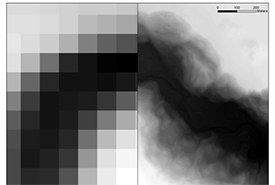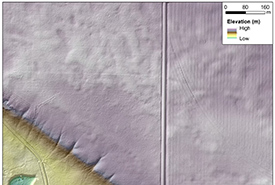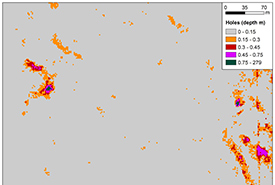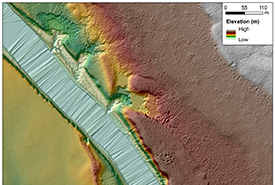Are you seeing the whole picture? Using elevation data to help conserve biodiversity

Elevation data showing the Beaver Creek River Valley. Historic data (100-metre resolution) vs. newly available LiDAR data (> one-metre resolution). (Image by NCC)
As a land planner, I am always looking for new ways to learn more about the landscapes in which the Nature Conservancy of Canada (NCC) works. Enter LiDAR (or light detection and ranging), a technology that has been around for decades but didn’t come of age until recently.
LiDAR, in its simplest form, is high-resolution elevation data. It uses lasers, usually mounted on aircraft, pulsed down at the Earth, to show us the local topography (or lay of the land). It can even “see” through trees and other vegetation! The use of LiDAR has allowed NCC to see landscape features that cannot be observed with satellite imagery or even the naked eye. It has proven to be an exceptionally useful tool in advancing our conservation work on the ground.
Related content
Here’s a list of the top four cool things we’ve done with LiDAR:
1. Differentiate between native prairie and agricultural fields

The field on the right has linear furrows, indicating a history of tillage and cropping. The field on the left has small furrows in the top half but lacks furrows in the bottom half, which may hint at the presence of unbroken, native prairie. (Image by NCC)
Shortly after settlement, most of Manitoba’s native prairie was converted to annual cropland or forage grassland. The presence (or in this case, absence) of tilled furrows in grasslands hints to the presence of unbroken, native prairie, which is becoming increasingly rare in the Canadian Prairies.
2. Detect sinkholes and caves

Sinkholes and caves are represented by darker (blue/purple) depressions on the landscape. (Image by NCC)
Data can be visualized in a way that highlights depressions, sinkholes and caves in limestone/karst landscapes. Caves are important landscape features for overwintering snakes and hibernating bats.
3. Rediscover “lost” HBC Fort Sites

Three linear depressions and a number of small, circular depressions may correspond to historic structures at the original HBC fort site, such as fort walls or cellars. (Image by NCC)
NCC's Fort Ellice Property in Manitoba was once home to not one, but two historic Hudson's Bay Company (HBC) fort sites. Although the location of the second fort site is publically known, the location of the original fort was less certain. LiDAR data was visualized to highlight local topographic relief, providing some additional clues to the potential location of the fort site.
4. Identify rare freshwater spring habitat

The crevice in the centre of this image was found on the steep valley wall of the Assiniboine River Valley. The crevice appears tiered, which is pooled water behind a series of beaver dams constructed inside the spring. (Image by NCC)
Freshwater springs are relatively uncommon wetlands that occur in places where groundwater seeps out of the ground. These wetlands are full of mineral rich, cold, flowing water. They are perfect habitat for species like nationally rare roundleaf monkeyflower.
NCC has also used LiDAR for many other applications:
- Identifying rare habitats like coastal beach ridges and inland cliffs;
- Differentiating between sandhill and mixed-grass prairie;
- Planning wetland restoration projects; and
- Assessing the threat of development on coastal marshes.
The technology is improving every day, and the availability of new LiDAR data is allowing biodiversity “treasure hunters” to find interesting, new features on the landscape faster than ever before.


